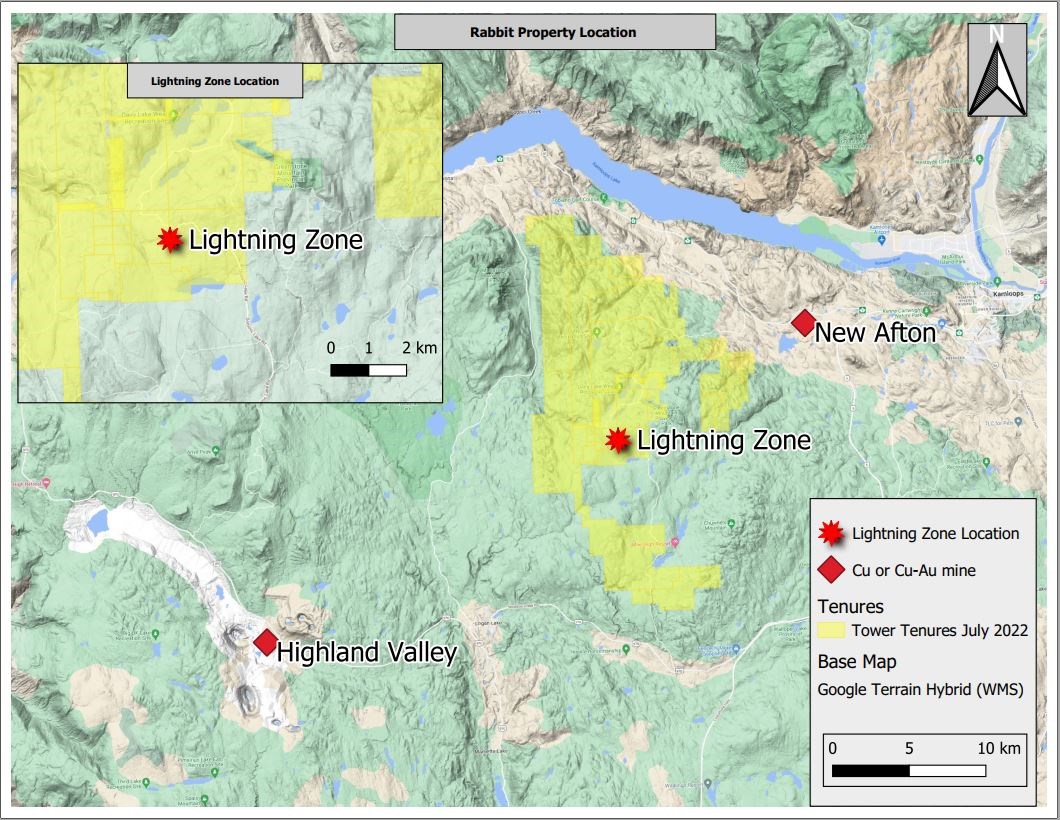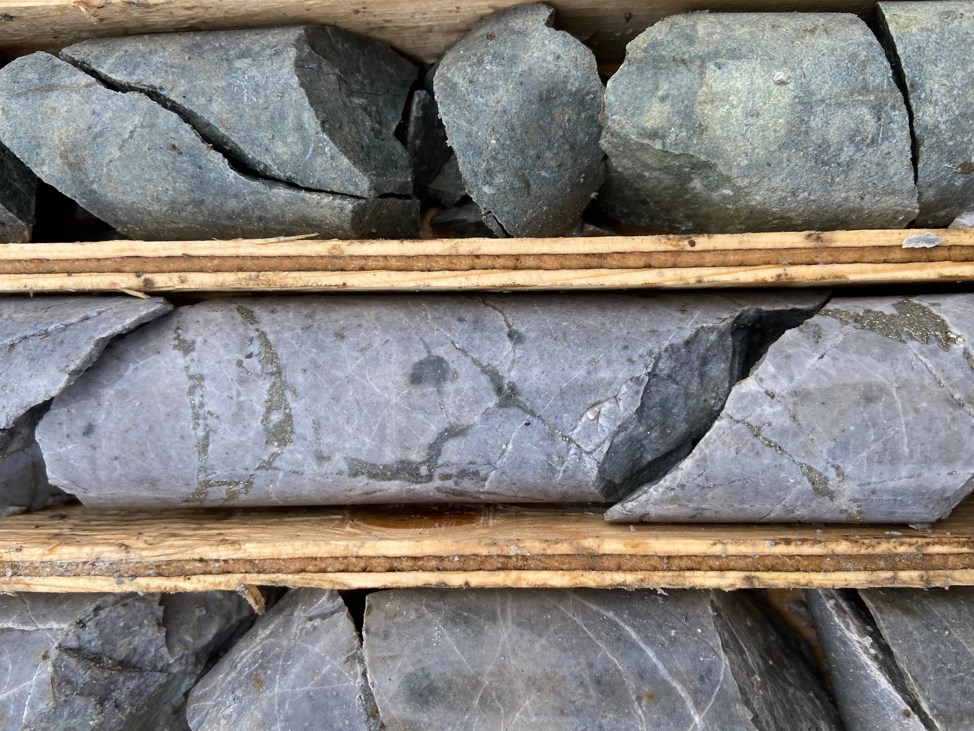Vancouver, British Columbia--(Newsfile Corp. - March 1, 2023) - Tower Resources Ltd. (TSXV: TWR) ("Tower" or the "Company") is pleased to announce that its inaugural four-hole diamond drill test at the head of the Central Train (see February 23, 2023 press release) on the Company's Rabbit North property near Kamloops, British Columbia, between New Gold's New Afton underground Cu-Au mine and Teck's Highland Valley open pit Cu-Mo mine (see Fig. 1), has resulted in the discovery of a new shear-hosted gold zone, Thunder, that is more strongly mineralized than the Lightning Zone and blossoms with depth.
New Thunder Zone Discovery
As planned for the current 2000 m drill program at Rabbit North (see February 2, 2023 press release) Tower drilled four exploratory holes at the head of the Central gold grain dispersal train (see Fig. 2) before moving the drill to further evaluate the Dominic Train and Lightning Zone.
The four holes, Nos. RN23-039 to 042, ranged in length from 263.0 to 480.6 metres and totaled 1403.1 metres. Three holes, Nos. 039, 041 and 042, intersected a new, strongly mineralized structure that Tower has designated the Thunder Zone because its discovery so closely follows that of the Lightning Zone. The first three holes were drilled at a flat dip of -45° to determine the strike of the structure while the final hole, No. 042, was drilled at a steeper, -65° dip from the same pad as Hole 041 to determine the dip which appears to be subvertical.
The Thunder Zone occurs within a shear-susceptible ash tuff horizon similar to that at Lightning but less disrupted by faulting and apparently striking south-southeast parallel to and beneath the Central Train. The three Thunder Zone intersections traced the mineralization for 200 m along strike and, remarkably, down to a depth of nearly 400 m (~1200 feet) below surface, leaving it wide open at both ends and down dip. The mineralized core sections vary in length from approximately 30 m to 130 m; most importantly, the longest intercept is also the deepest and most strongly mineralized.
The Thunder Zone mineralization is characterized by much stronger veining and pyritization, in some intervals semi-massive (see Fig. 3), than that of the Lightning Zone (see Fig. 4). The pyrite in the veins is also coarser grained and rare specks of visible gold up to 1 mm are present, reflecting the coarse average size of the glacially dispersed gold grains in the Central Train relative to those in the Dominic Lake Train down-ice from the Lightning Zone. Pyritization is most intense in the long, deep intersection of Hole 042 and the pyrite is increasingly accompanied by chalcopyrite, potentially indicating a significant Cu bonus.
Joe Dhami, President and CEO of Tower resources, commented on the significance of the new discovery to Tower: "The Thunder Zone lies 400m west of the Lightning Zone and was discovered by utilizing a till sampling program. Tower Resources will continue to use this process to test the western extension of the Thunder Zone to assess the future economic potential of this discovery."
Stu Averill, P.Geo. and a Director of the Company, added: "The first core from Thunder, especially the deep core from Hole 042, is the most attractive of any gold discovery that I have been involved in during my 50+ years of mineral exploration. The evident blossoming of the mineralization with depth is what every geologist dreams of but rarely experiences."
Drill Core on Display at PDAC
Core specimens from both the Thunder and Lightning discovery holes will be on display at Booth 910 of Overburden Drilling Management (ODM) on the Trade Show floor at PDAC in Toronto from March 5 to 8, 2023.
All Tower shareholders and convention delegates are invited to compare the core from the two zones and discuss the deposit model and mineralization controls.
Turnaround time at Canadian analytical laboratories has improved considerably from last year and Tower expects to receive the first assays from Thunder in late March.
Methods and Qualified Person
The drill core was logged at Tower's leased, fully equipped core facility near Kamloops by Matthew Husslage, BSc. Geology, and Lauren Vollo, BSc. Geology. Both have extensive experience with B.C. gold and copper deposits and Mr. Husslage has managed or co-managed all of Tower's Rabbit North diamond drilling programs since the discovery of the Lightning Zone in December 2021.
Split samples of the core, generally 1-2 m in length, are being delivered directly to Activation Laboratories (ActLabs) in Kamloops, BC, a laboratory certified as ISO/IEC 17025 Accredited (Lab 790) by the Standards Council of Canada. QA/QC samples including blanks and standards are inserted regularly into the sample sequence at a ratio of approximately 1:20.
The samples are being analyzed for Au by fire assay and ICP-OES and for Ag and 36 additional elements by ICP-OES using a four-acid, near-total digestion. Any over-limit (>5 g/t) Au analyses are repeated using the same fire assay procedure but with a gravimetric rather than ICP finish.
The technical content of this news release has been reviewed and approved by Stuart Averill, P.Geo., a Director of the Company, and a Qualified Person as defined by National Instrument 43-101.
About Tower Resources
Tower is a Canadian based mineral exploration company focused on the discovery and advancement of economic mineral projects in the Americas. The Company's key exploration assets, both in B.C., are the Rabbit North copper-gold porphyry project located between the New Afton copper-gold and Highland Valley copper mines in the Kamloops mining district and the Nechako gold-silver project near Artemis' Blackwater project.
On behalf of the Board of Directors
Tower Resources Ltd.
Joe Dhami, President and CEO
(778) 996-4730
www.towerresources.ca
Reader Advisory
This news release may contain statements which constitute "forward-looking information", including statements regarding the plans, intentions, beliefs and current expectations of the Company, its directors, or its officers with respect to the future business activities of the Company. The words "may", "would", "could", "will", "intend", "plan", "anticipate", "believe", "estimate", "expect" and similar expressions, as they relate to the Company, or its management, are intended to identify such forward-looking statements. Investors are cautioned that any such forward-looking statements are not guarantees of future business activities and involve risks and uncertainties, and that the Company's future business activities may differ materially from those in the forward-looking statements as a result of various factors, including, but not limited to, fluctuations in market prices, successes of the operations of the Company, continued availability of capital and financing and general economic, market or business conditions. There can be no assurances that such information will prove accurate and, therefore, readers are advised to rely on their own evaluation of such uncertainties. The Company does not assume any obligation to update any forward-looking information except as required under the applicable securities laws.
Neither TSX Venture Exchange nor its Regulation Services Provider (as that term is defined in policies of the TSX Venture Exchange) accepts responsibility for the adequacy or accuracy of this release.
Figure 1 – Location of Tower's Rabbit North property relative to the active mines of the Kamloops district.
To view an enhanced version of this graphic, please visit:
https://images.newsfilecorp.com/files/5023/156664_580c58000465db70_002full.jpg
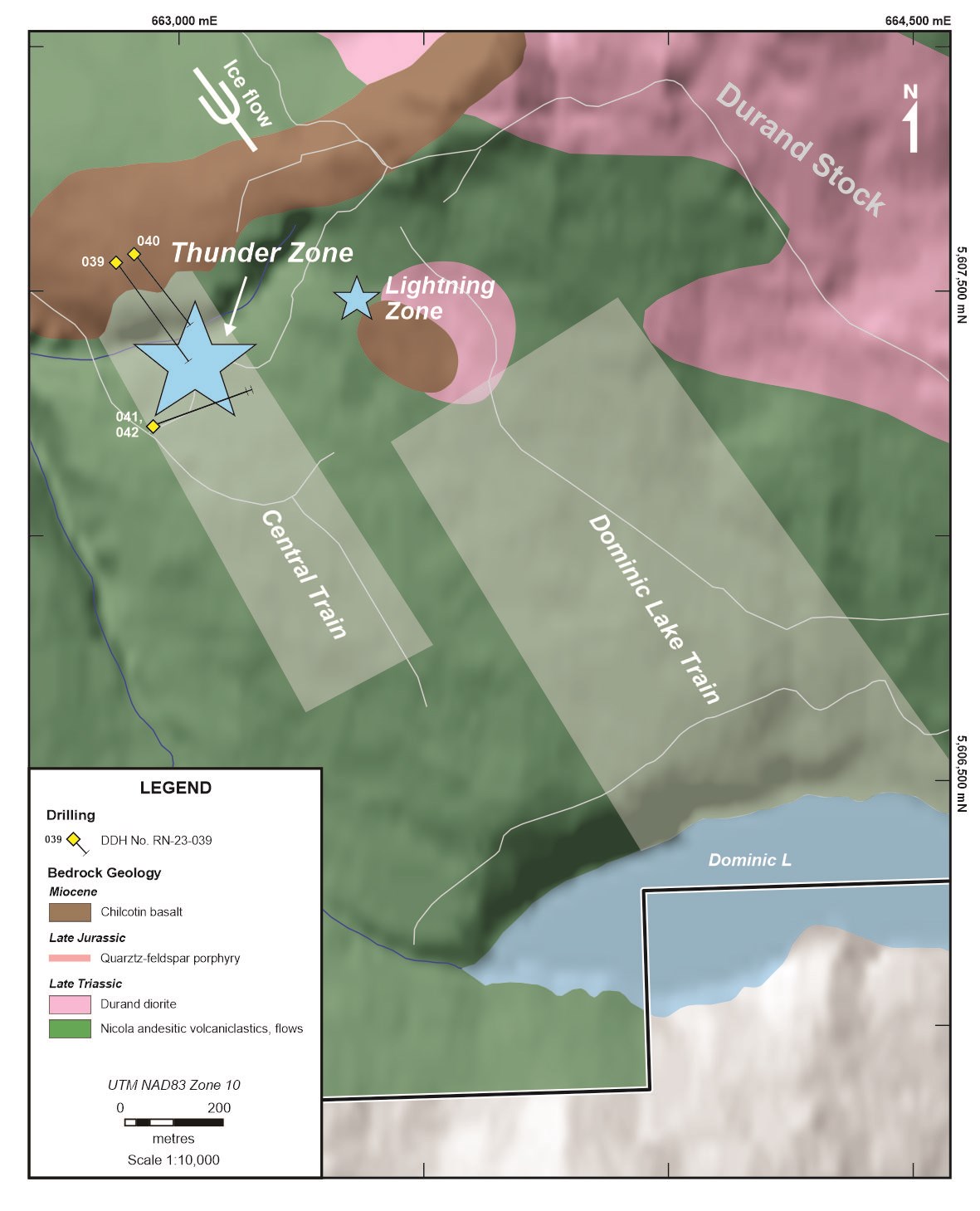
Figure 2 – Locations of the four exploratory diamond drill holes and new Thunder Zone relative to the Central gold grain dispersal train. Chilcotin basalt cover flows were intersected in all four drill holes and thus may overlie part of the mineralized zone.
To view an enhanced version of this graphic, please visit:
https://images.newsfilecorp.com/files/5023/156664_580c58000465db70_003full.jpg
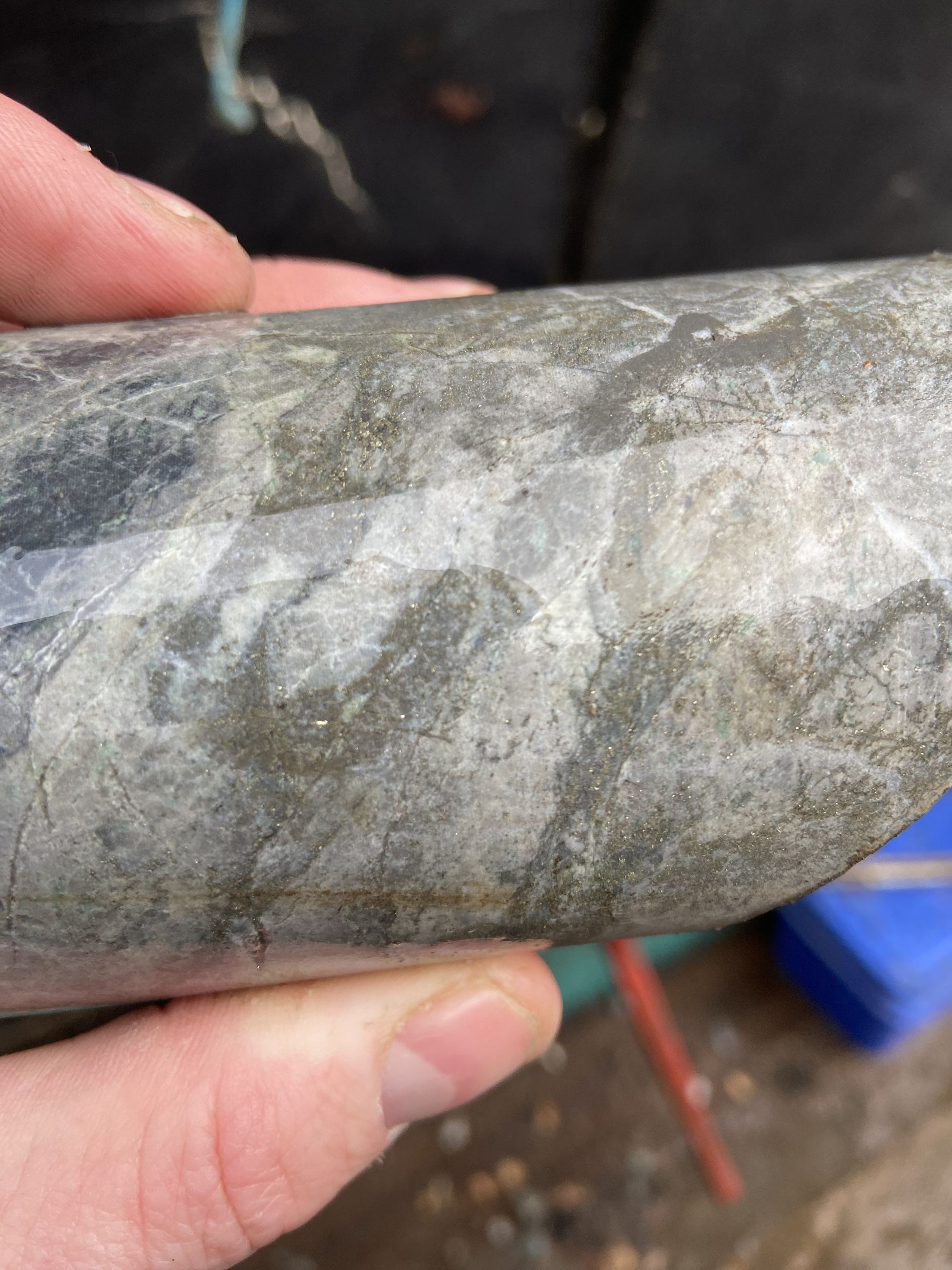
Figure 3a – Strongly silica-sericite-pyrite (QSP) altered and mineralized ash tuff from Discovery Hole RN23-039, Thunder Zone. Note the high pyrite content relative to the Lightning Zone and the presence of minor green fuchsite.
To view an enhanced version of this graphic, please visit:
https://images.newsfilecorp.com/files/5023/156664_580c58000465db70_004full.jpg
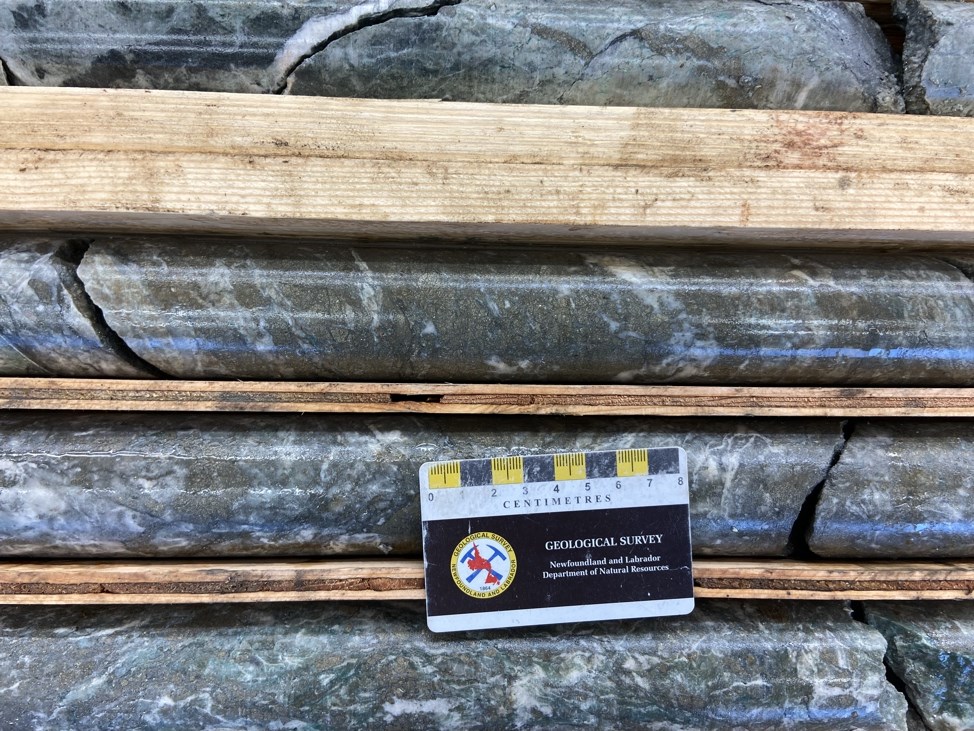
Figure 3b – Very strongly QSP altered and mineralized ash tuff from Hole 042, Thunder Zone. Note that pyrite is both more abundant and persistent than in the Lightning Zone.
To view an enhanced version of this graphic, please visit:
https://images.newsfilecorp.com/files/5023/156664_580c58000465db70_005full.jpg
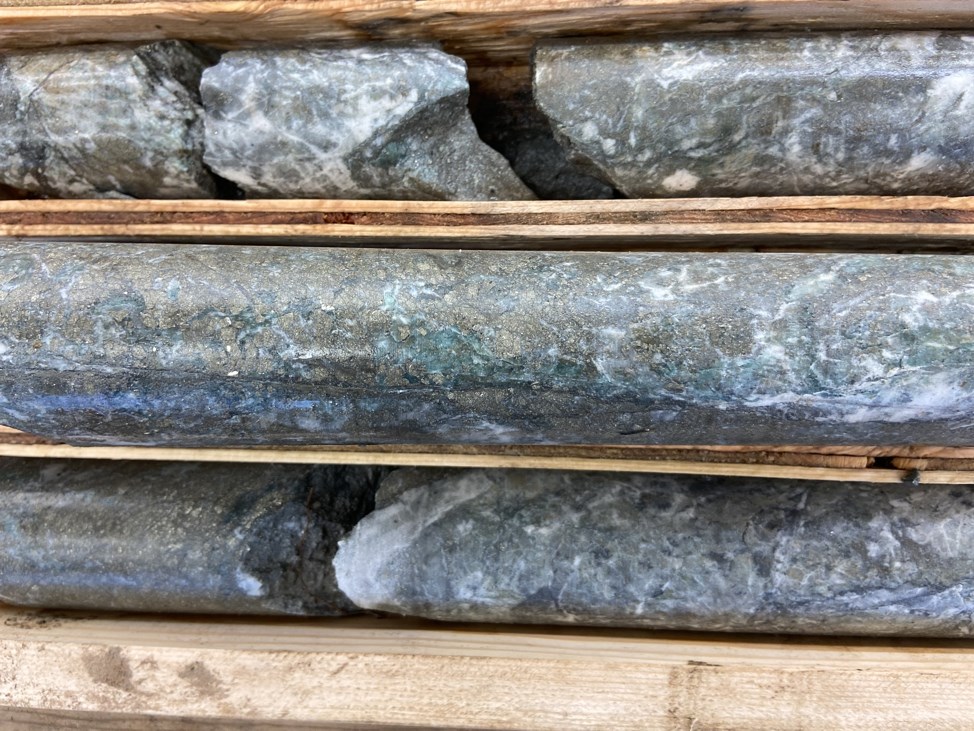
Figure 3c – Very strongly QSP altered and mineralized ash tuff with abundant green fuchsite from Hole 042, Thunder Zone.
To view an enhanced version of this graphic, please visit:
https://images.newsfilecorp.com/files/5023/156664_580c58000465db70_006full.jpg
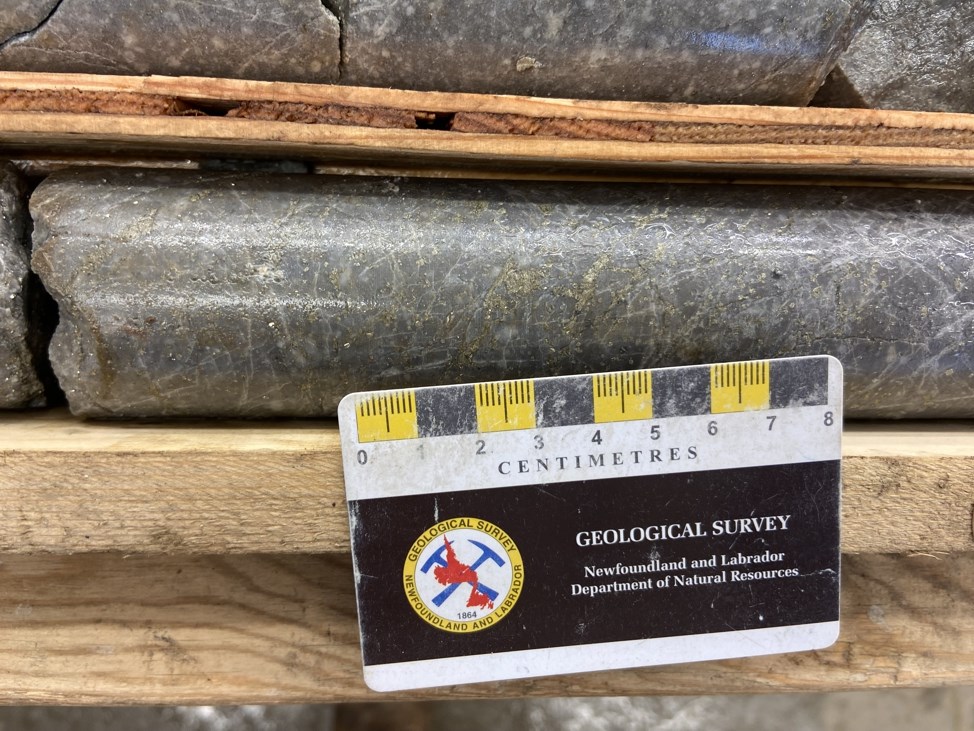
Figure 3d – Intensely fractured quartz vein with abundant chalcopyrite adjacent to a QSP altered dyke of quartz-feldspar porphyry, Hole 042, Thunder Zone.
To view an enhanced version of this graphic, please visit:
https://images.newsfilecorp.com/files/5023/156664_580c58000465db70_007full.jpg
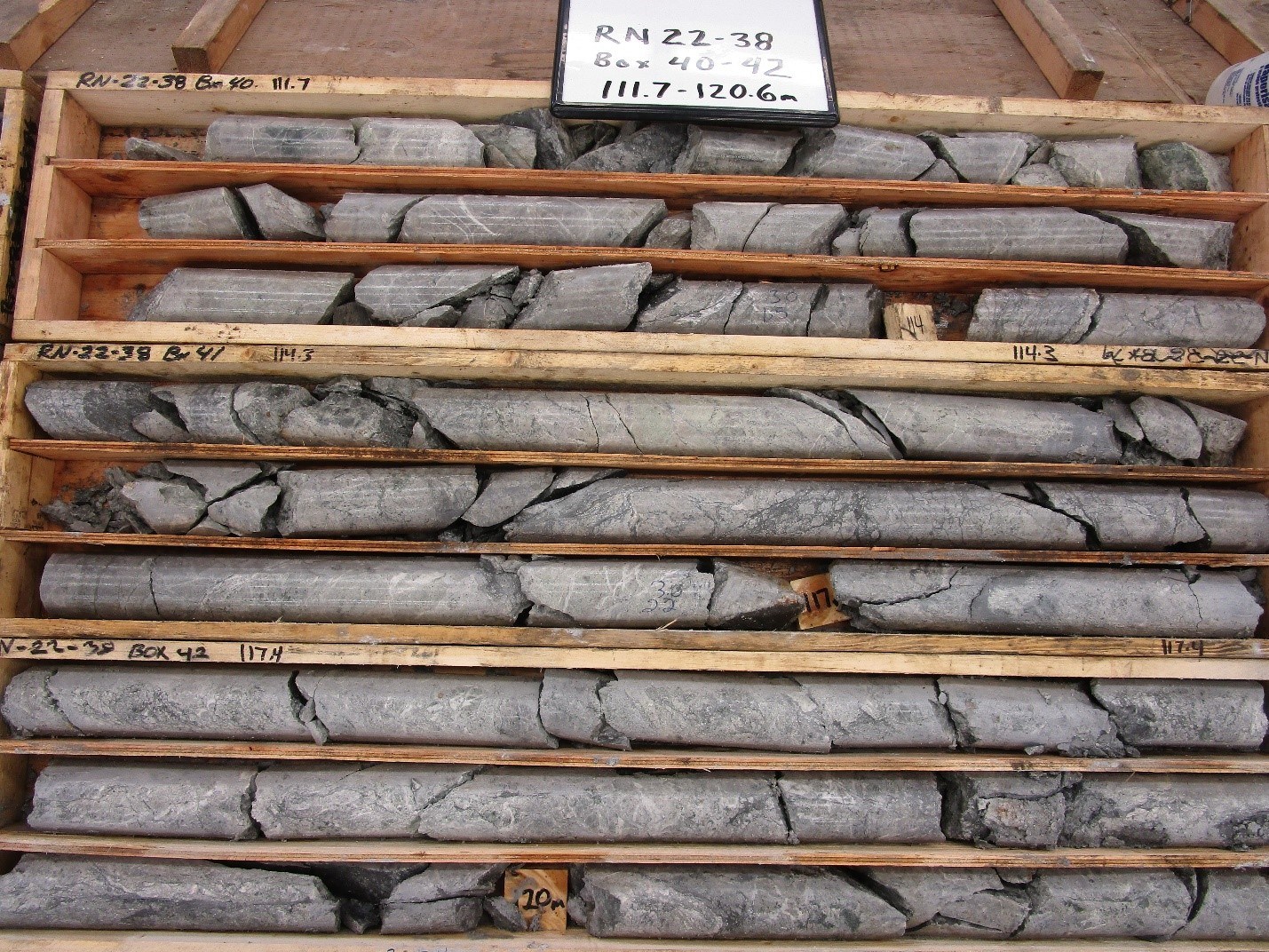
Figure 4a – Overview of strongly silica-sericite-pyrite (QSP) altered ash tuff from Hole RN22-038, Lightning Zone. Note the highly deformed, fragile condition of the core - a characteristic feature of the Lightning Zone. This 9 m section averaged ~0.4 g/t Au.
To view an enhanced version of this graphic, please visit:
https://images.newsfilecorp.com/files/5023/156664_580c58000465db70_008full.jpg
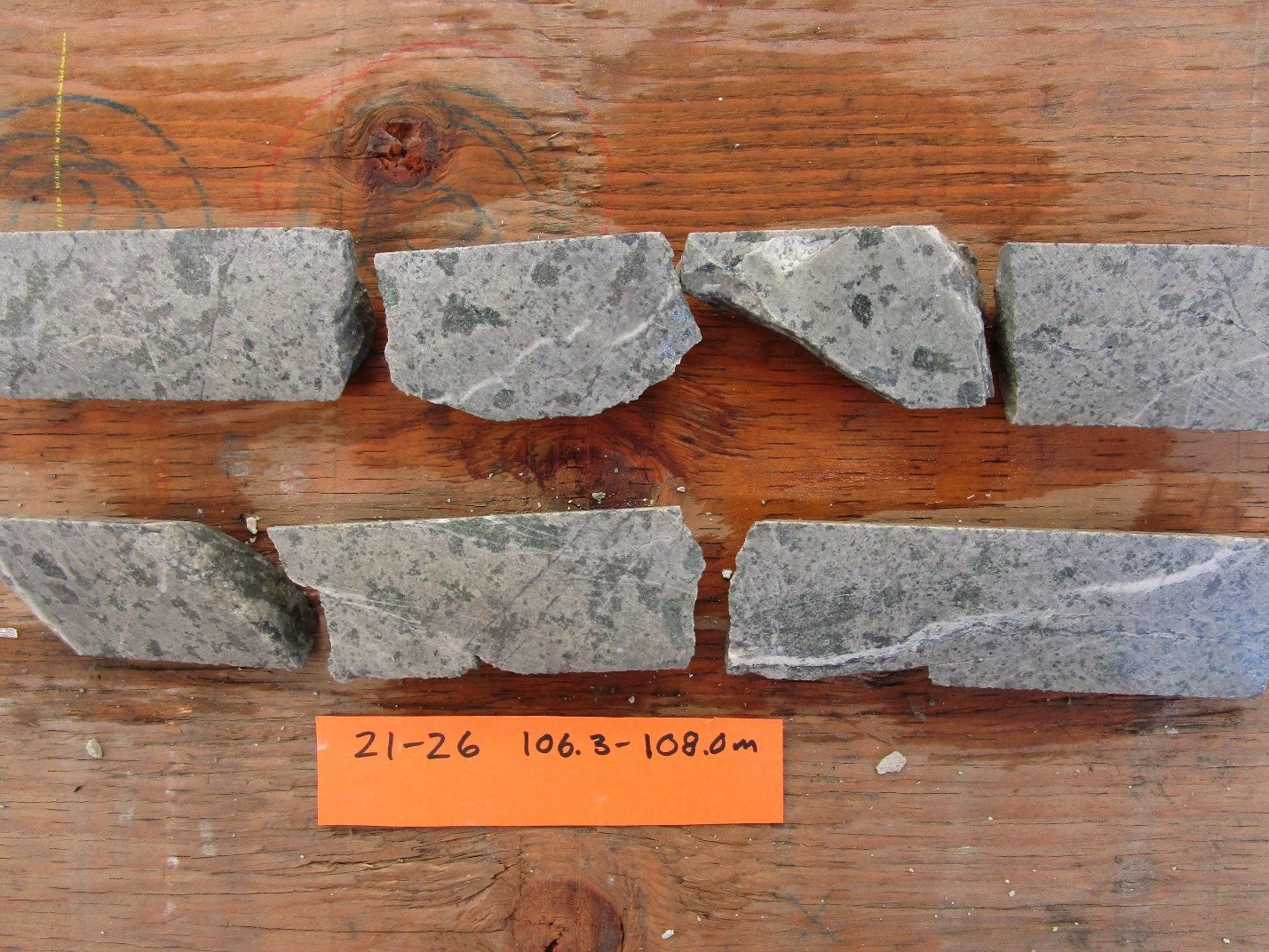
Figure 4b – Moderately QSP-altered and mineralized ash to lapilli tuff from discovery hole No. RN21-026, Lightning Zone. This section averaged 0.21 g/t Au.
To view an enhanced version of this graphic, please visit:
https://images.newsfilecorp.com/files/5023/156664_580c58000465db70_009full.jpg
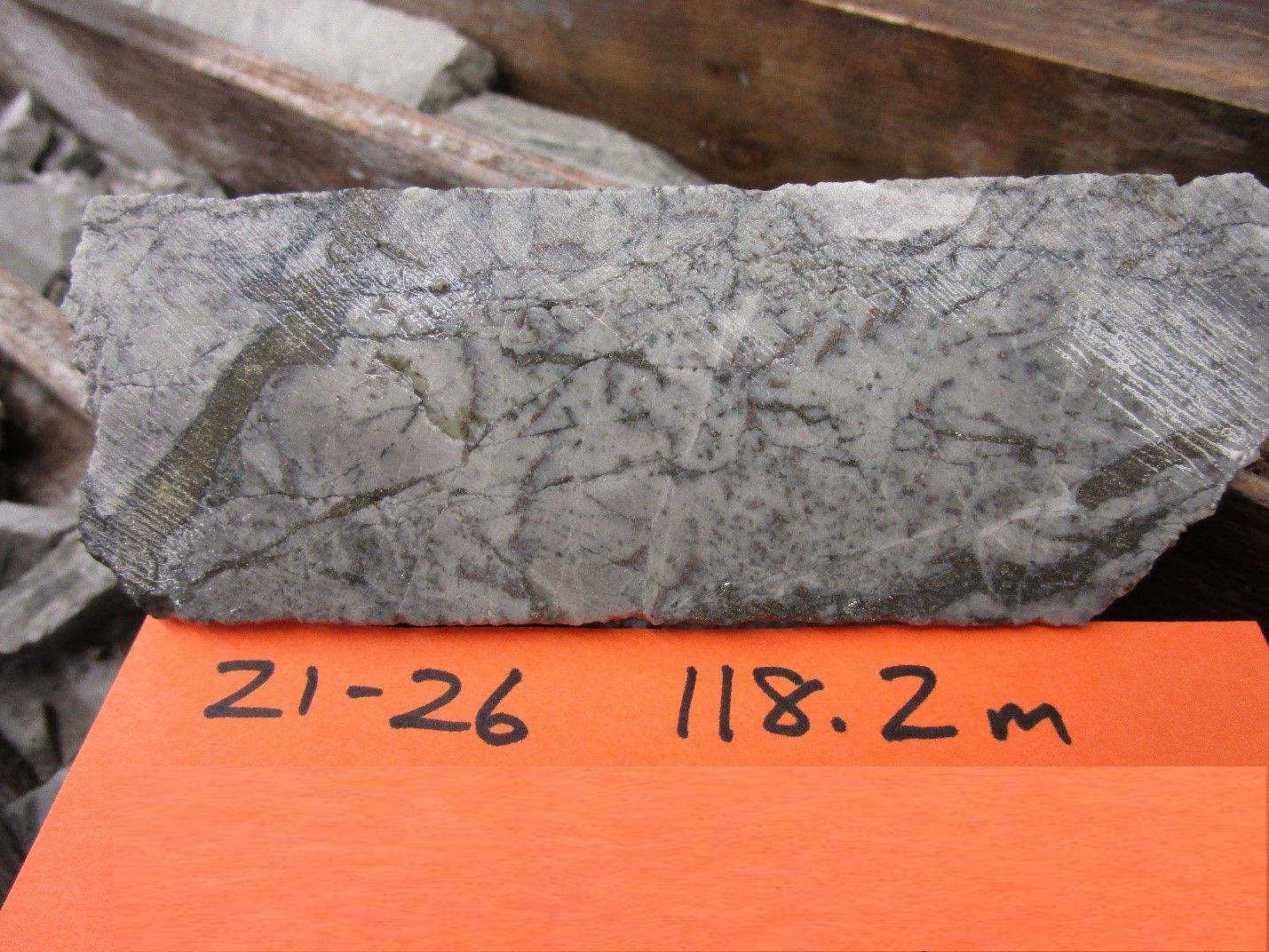
Figure 4c – Strongly QSP-altered and mineralized ash tuff from discovery hole No. RN21-026. This specimen is from a 1.9 m interval that assayed 7.84 g/t Au.
To view an enhanced version of this graphic, please visit:
https://images.newsfilecorp.com/files/5023/156664_580c58000465db70_010full.jpg
Figure 4d – Strongly QSP-altered and mineralized ash tuff in contact with epidote-altered, unmineralized tuff-breccia from Hole 029, Lightning Zone.
To view an enhanced version of this graphic, please visit:
https://images.newsfilecorp.com/files/5023/156664_580c58000465db70_011full.jpg
To view the source version of this press release, please visit https://www.newsfilecorp.com/release/156664


